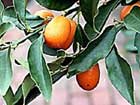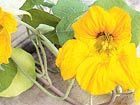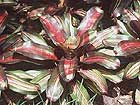Plant Profiles
Click on the first letter of the common name of the plant you wish more information about.
A | B | C | D | E | F | G | H | I | J | K | L | M | N | O | P | Q | R | S | T | U | V | W | X | Y | Z
N

Nagami Kumquat
Scientific Name: Fortunella margarita
Growth Habit: A small evergreen tree with a rounded shape growing to 10 feet tall. The leaves are deep green with an elliptical shape growing to 3 inches long and 1 inch wide.
Light: Plant in a full-sun location
Feedings: Apply a citrus fertilizer once each month in March, May, August and early October. Apply 1/4-pound for each inch of circumference measured 6 inches above the ground.
Water Needs: Tolerates short periods of drought, but grows best with weekly waterings during hot, dry weather.
Ease of Culture: Easy.
Propagation: Start trees by grafting or air-layering.
Hardiness: Hardy.
Major Problems: Subject to common citrus pests including leaf miner, aphids, scale insects and fungal leaf spots. Trees tolerate these pests, and sprays are seldom needed.
Pruning: Train the tree to a single trunk until the tree is a few feet high and then allow branching to develop the canopy. Remove shoots forming below the graft or along the trunk that compete with the desired limbs or affect maintenance. Very little trimming is needed to shape the tree.
Uses: An ornamental citrus tree for large and small landscapes. Treat as a traditional citrus tree to form a backdrop for the landscape or feature as a small tree for garden plantings. Gardeners with small designs often grow a tree in a container or feature it as an edible in-ground accent plant near a patio. Trees produce the familiar white fragrant citrus blossom in late February and March and then ripen oblong fruits more than 1 inch long November through April. The fruits including the peel are eaten fresh or used as candied fruits and in marmalades.
Florida Native: No; native to China.

Nasturtium
Scientific Name: Tropaeolum majus
Growth Habit: A sprawling annual growing to 15 inches high and 24 inches wide. The leaves are deep green and rounded with a wavy margin, growing to 4 inches in diameter.
Light: Plant in full-sun to lightly shaded locations.
Feedings: Apply a general garden fertilizer monthly.
Water Needs: Prefers a moist soil; water at least weekly.
Ease of Culture: Easy.
Propagation: Start plants from seed.
Hardiness: Tender; damaged by hard frosts and freezes but needs the cooler weather for best growth.
Major Problems: Leaves may be damaged by caterpillars and slugs. But the leaves can be picked off as needed. Aphids also may damage growth and can be controlled with a natural soap spray.
Pruning: Vining plants can grow out of bounds and may need periodic trimming. Also, remove old flowers to encourage additional blooms.
Uses: A colorful winter flower for cool-season beds and container gardens. The trailing stems adapt to hanging baskets and are attractive, creeping over the sides of planters. Nasturtiums started in early fall are often in bloom November through June, opening 2-inch or larger yellow, orange or red blossoms. Many gardeners like to add the flowers and leaves to salads or sandwiches. If used as a food, make sure they are pesticide-free.
Florida Native: No; native to Peru, Chile and other South American countries.

Neoregelia Bromeliad
Scientific Name: Neoregelia hybrid
Growth Habit: Evergreen perennials with an open cluster of foliage arising from near the ground growing to 1 foot tall and 18 inches wide. The leaves are stiff and slightly curved and grow to a few inches wide and a foot long.
Light: Tolerates full sun to shade; grows best in filtered-sun locations.
Feedings: Lightly scatter a general garden fertilizer over the surface of the soil once each month in April, June and September. It also can be fed with a weak fertilizer solution applied over the tops of plantings every other month April through October.
Water Needs: Drought tolerant; water every 10 to 14 days.
Ease of Culture: Easy.
Propagation: Divide older clusters.
Hardiness: Medium; damaged by freezing weather. Most plants escape damage when growing under trees and large shrubs. Cold water dripping off plants above can damage the foliage. Prize specimens should be grown in containers or dug and moved to a warm location during freezes.
Major Problems: Scale insects may feed on the foliage, causing yellow spots and gradual decline. Control with an oil spray following label instructions.
Pruning: Older plants gradually decline after flowering. Gardeners can prune out the declining clumps to improve the appearance of beds and to make room for the offshoots. Foliage damaged by cold weather can be removed during March.
Uses: Cluster plants to use as a ground cover and accent feature for the landscape. Neoregelias tolerate the sun but are best used in shady locations where fewer ornamental plants are available to provide color. Individual plants are commonly grown in containers and added to the patio, balcony or entrance areas.
Florida Native: No: native to Brazil.

